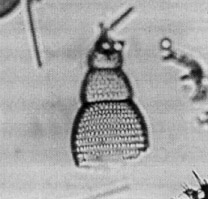 Siphostichartus
corona (Haeckel)
Siphostichartus
corona (Haeckel) Siphostichartus
corona (Haeckel)
Siphostichartus
corona (Haeckel)Cyrtophormis (Acanthocyrtis) corona Haeckel, 1887, p.1462, pl.77, fig.15
Siphostichartus corona (Haeckel), Nigrini, 1977, p.257, pl.2, figs.5-7 (with synonymy)
Shell smooth, hyaline, conical, compressed laterally. Cephalis hemispherical with a few circular pores, well-developed three-bladed apical horn, and prominent duck-billed vertical tube; apical spine free of cephalic wall and axial rod well developed. Thorax inflated, slightly heavier than the rest of the shell; two or three transverse rows of circular pores. Abdomen inflated conical with four to seven transverse rows of circular pores. Fourth segment considerably larger than the others, usually contracting distally and without a differentiated peristome; numerous widely spaced transverse rows of small circular pores. Termination ragged or shell may terminate along a pore row, thus giving the appearance of terminal "teeth" (cf. Riedel and Sanfilippo, 1971, p.1600). Intersegmental strictures curved, not pronounced internally (Nigrini, 1977).
Total length (excluding apical horn) 135-190 µm; length of abdomen 30-40 µm; length of fourth segment 70-105 µm; maximum breadth (across fourth segment) 70-95 µm (Nigrini, 1977).
Four segmented, hyaline, laterally compressed artostrobiid with a prominent duck-billed vertical tube. The segmental divisions are well marked externally, and there is no peristome.
Rather constant. Early forms more porous, later forms more hyaline. There is a similar form in which the third segment appears to be divided into two segments. The relationship of this morphotype to S. corona has not been examined.
This low-latitude species is rare at time of first appearance in the Stichocorys wolffii Zone; few to common from Dorcadospyris alata Zone to Didymocyrtis penultima Zone; last rare occurrences in the Stichocorys peregrina Zone.
Appears to have developed from Siphostichartus praecorona Nigrini (1977, p.258) in which the third segment has only two rows of pores and a less prominent apical horn and vertical tube.